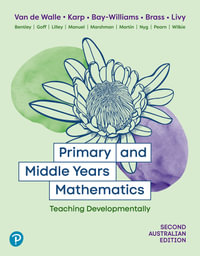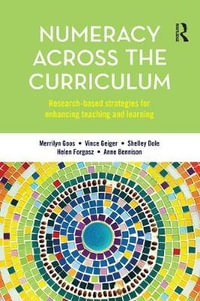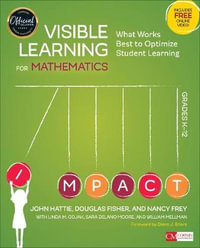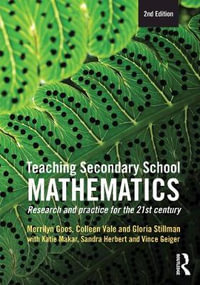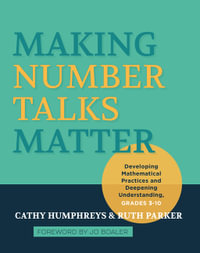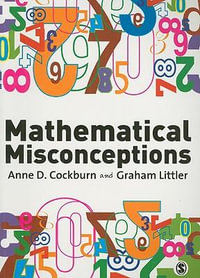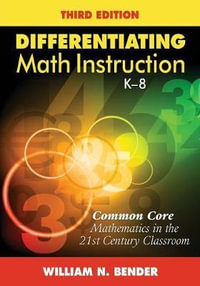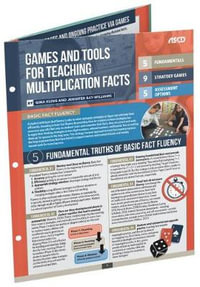Now in its fourth edition--with more than 50 new questions and a new chapter on financial literacy--this bestselling resource helps experienced and novice teachers effectively and efficiently differentiate mathematics instruction in grades K-8. Math education expert Marian Small shows teachers how to get started and become expert at using two powerful and universal strategies: Open Questions and Parallel Tasks. This edition is even easier for teachers to use in all quality state standards environments, including direct links to content standards and standards for mathematical practice. Parallel tasks and question examples are provided at each grade band: K-2, 3-5, and 6-8. Along with each example, the text describes how teachers can evoke productive conversations that meet the needs of a broad range of learners.
Book Features:
- New tasks and questions to develop financial literacy.
- Connection of tasks and questions to standards and mathematical big ideas.
- About 500 tasks and questions that teachers can adapt or use as-is.
- Teaching tips and task variations.
- A template to help teachers build new tasks.
- "Look-fors" to see student thinking and diagnose difficulties.
- Guidance for using follow-up questions and math conversations to create a rich math classroom.
Industry Reviews
"When I read Marian Small's work, I see the power of math revealed, but I also see her work opening that power to so many students who might never otherwise experience it...I am a disciple of her approach to differentiating math!"- From the Foreword by Carol Ann Tomlinson, University of Virginia;
"Successful instruction causes students to wonder, conjecture, investigate, collaborate, and talk math. Good questioning is central to all the above, and for 'knowing what students know.' Small's book focuses on the big ideas of mathematics, with questions, examples, and parallel tasks that assess student understanding and promote learning. This book is a must-read for every preservice and inservice teacher."- Carole Greenes, professor emerita, mathematics education, Arizona State University;
"In a classroom full of students, it can be hard to meet the needs of all learners. That is where this book has your back. Marian Small provides meaningful tasks while modeling how simple tweaks and intentional number choice can unlock students' mathematical potential."- Graham Fletcher, math specialist;
"Throughout her career, Marian Small has shown that 'differentiation' in math class does not mean 'ability grouping' or breaking mathematics down into tiny, digestible subskills. Marian's kind of differentiation means focusing on big ideas, offering students choice, and being curious about students' thinking. In the 4th edition of this essential book, Marian teaches us powerful questioning techniques with her trademark clarity and provides plenty of specific examples across the content strands and grade bands. We can use these questions with our students immediately and internalize Marian's teaching strategies through practice. How lucky for us that she has crafted these questions that will encourage student thinking, build our curiosity, and teach us to craft good questions of our own."- Tracy Johnston Zager, math coach;
"I just finished teaching an elementary math methods course to teacher candidates in a graduate program. I wish I had had Marian Small's Good Questions: Great Ways to Differentiate Mathematics Instruction in the Standards-Based Classroom to use with these preservice teachers. Small covers all the key content in the Common Core PreK-8 math curriculum, and she addresses the topic of open questions in a very accessible way. She walks the reader step-by-step through how to teach the big ideas in the CCSS PreK-8 math curriculum using specified open questions. At the same time, she provides a menu of choices so teachers can draw from their own expertise to select the open questions that they see fit. Each chapter explains math content in an easy-to-reference manner. It is like having a reference book and a teaching coach all in one book. This semester, I watched teacher candidates struggle with how to lead a Number Talk, because they were not sure which open questions to ask to facilitate learning. Small's book provides the guidance that they need. I look forward to using Small's book the next time I teach Elementary Math Methods to teacher candidates. Inservice teachers will also benefit from the practical ideas about how to promote higher-order math thinking by asking the open questions outlined in Good Questions."- Felicia Darling, math instructor at Santa Rosa Junior College

